Japanese Chin
Canis lupus
Alert, intelligent and independent!
Advertisement
Japanese Chin Scientific Classification
- Kingdom
- Animalia
- Phylum
- Chordata
- Class
- Mammalia
- Order
- Carnivora
- Family
- Canidae
- Genus
- Canis
- Scientific Name
- Canis lupus
Read our Complete Guide to Classification of Animals.
Japanese Chin Conservation Status
Japanese Chin Facts
Japanese Chin as a Pet:
- General Health
- Energy Level
- Shedability
- Trainability
- Intelligence
- Tendency to Chew
- Size
- Family and kid friendliness
- Yappiness / Barking
- Moderate
- Separation Anxiety
- High
- Preferred Temperature
- Average climate
- Exercise Needs
- Low
- Friendly With Other Dogs
- Moderate
- Pure bred cost to own
- $600-$2,500
- Dog group
- Toy
- Male weight
- 11-12 lbs
- Female weight
- 11-12 lbs
This post may contain affiliate links to our partners like Chewy, Amazon, and others. Purchasing through these helps us further the A-Z Animals mission to educate about the world's species.
View all of the Japanese Chin images!
A Japanese Chin is an affectionate, intelligent dog with a playful nature.

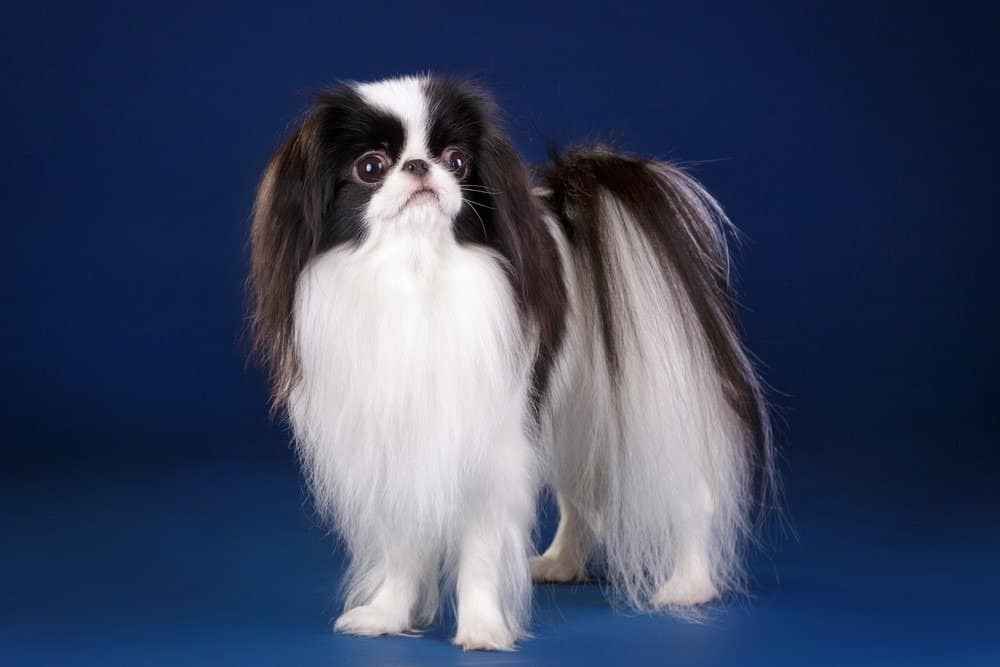
Considered a toy dog, the Japanese Chin’s heritage goes back to the 1600s.
See all of our expert product reviews.
©Natalia Fedosova/Shutterstock.com
A Japanese Chin belongs to the Toy group of dogs and was bred to be the perfect companion for its owner. Its soft coat and delicate steps make it more cat-like than dog-like.
The origin of this breed is unknown. Some believe it was brought from China as a royal gift in AD 732, but others say a Japanese empress was given the dog as much as two centuries earlier. Images of these dogs have been spotted on ancient pieces of pottery and artwork found in Chinese temples. They are thought to be close relatives of the Tibetan Spaniel. This is not hard to believe considering the similarity in the appearance and colors of the two breeds. Pekingese are also relatives of these dogs.
Another version of the Chin’s history has the breed arriving in Japan about AD 1000. It is known that in 1613, the Japanese Chin was brought to England. Since the late 1800s, this dog has been generally a lap dogs for upper class ladies, but today they are also companion dogs to anyone who fancies the breed.
Health and Entertainment for your Japanese Chin
- The Best Wet Food for Senior Dogs
- The Best Dog Food for Labrador Retrievers (Senior, Puppy, and Adult)
- These Are the Best Probiotics for Dogs (They Actually Work)
- Victor Senior Healthy Weight Dog Food Review: Recalls, Pros, Cons, and More
- The Best Dog Food for Small Dogs (Puppy, Adult, Senior): Ranked and Reviewed
See all of our expert product reviews.
3 Pros and Cons of Ownership
| Pros! | Cons! |
|---|---|
| A constant companion Japanese Chins love to stick by their owner no matter what they are doing. | Not good with small children Because of their small size, these dogs are wary of being stepped on or hurt. Out of self-preservation, they may snap at toddlers and other small children who fall nearby. |
| A low amount of exercise needed A slow walk for about 20 minutes per day is all the exercise this lapdog needs. | Fast-growing nails Japanese Chins have nails that grow very quickly and need to be trimmed on a regular basis. |
| Adaptable to its environment This toy dog is able to live happily in an apartment, large home, or anything in-between. | Health Issues This dog can develop breathing issues due to its short facial structure. |
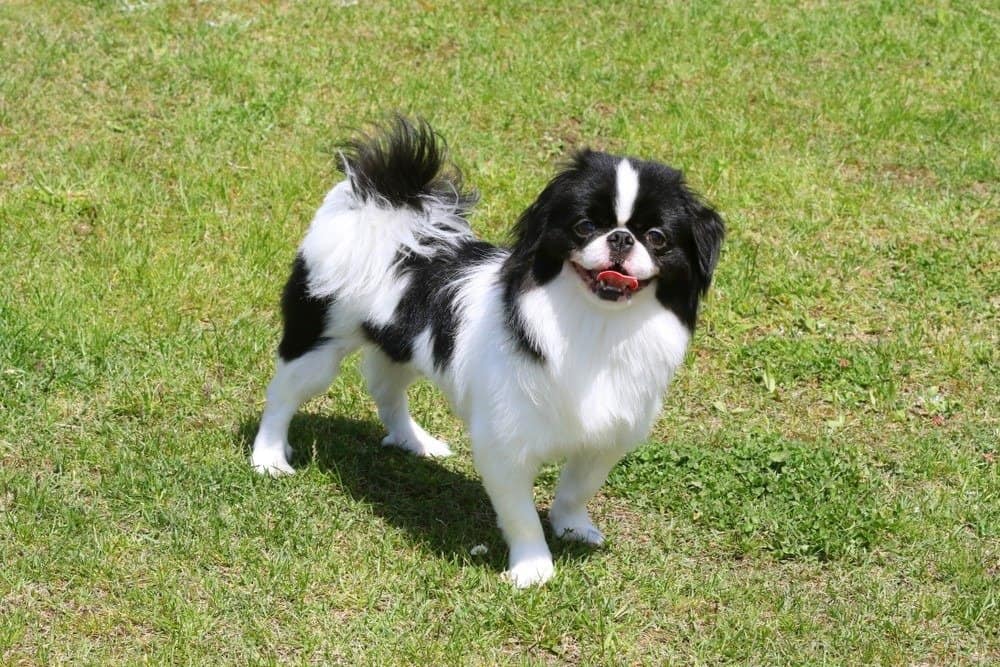
©Rin Seiko/Shutterstock.com
Japanese Chin Size and Weight
A Japanese Chin is a Toy dog with a coat of medium length hair. A male is 10 inches tall at the withers and a female is 9 inches tall. Both males and females can weigh up to 12lbs. Puppies weigh about 4lbs at 8 weeks old. They are considered fully grown at 9 months.
| Male | Female | |
|---|---|---|
| Height | 8-11 inches tall | 8-11 inches tall |
| Weight | 7-9 lbs, fully grown | 7-9bs, fully grown |
Japanese Chin Common Health Issues
These descendants of the Tibetan spaniel have some common health issues. One of them is heart disease. It usually comes to older dogs in the form of a weakened heart valve. Another health issue is patellar luxation. This is a condition where the knee slips out of the proper position. Sometimes the dog can move its leg in a way that realigns its knee while more severe cases require medical treatment. Portosystemic shunt is another health issue particular to small dogs like these. It’s a condition where the liver doesn’t receive proper blood flow and can’t remove toxins from the bloodstream.
This toy dog also has strabismus. Strabismus is a condition where the dog’s eyes are out of alignment and go in different directions. This is not a health problem, but it’s a condition that can affect the dog’s depth perception.
The most common health issues of Japanese Chins include:
- Heart disease
- Patellar luxation
- Portosystemic shunt
- Strabismus
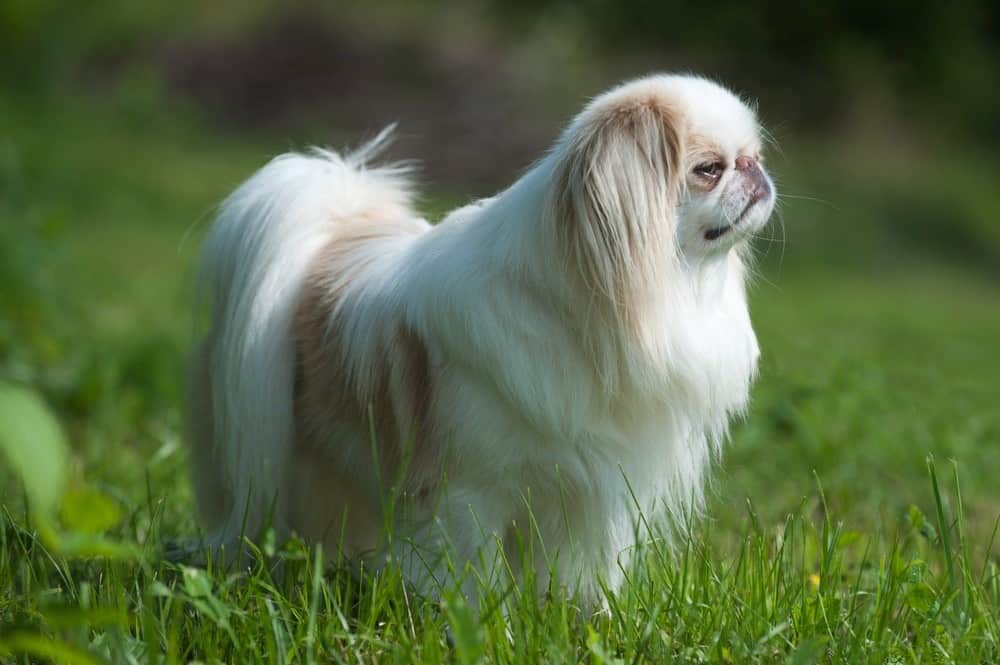
Brown coloring is rare, but a Japanese Chiin always has a sweet personality.
©KaliAntye/Shutterstock.com
Temperament and Behavior
These dogs have a sweet personality. This is one of the things that makes them an ideal choice for a family that wants a lap dog. Other notable traits of this dog include intelligence and loyalty. A Japanese Chin is the type of dog that follows its owner around as he or she goes about daily tasks.
Its curiosity is almost cat-like! In fact, cats and Japanese Chins share a lot of traits. These dogs are great at climbing onto chairs and other furniture. Another thing that makes them cat-like is they groom themselves by licking their paws and rubbing their faces.
This breed is a good dog for families with older children. Sometimes a the dog can display jumpy behavior around toddlers and young children because they have a tendency to fall and do unexpected things. Generally, older children are able to be more careful around this dog and understand the need to treat it with gentleness.
These little dogs are suspicious of strangers and will usually alert the household when someone appears at the door.
Care
Learning how to take proper care of this pet can help it to enjoy a long, healthy life with the family. The right diet and proper exercise both contribute to the vigorous health of this Toy dog.
The Best Dog Food
Feeding a puppy or an adult Japanese Chin a balanced diet can prevent some of the common health issues connected with this breed. For example, these dogs can experience heart disease. With this in mind, owners should check out legume-free dog foods and the link between dog foods containing legumes and heart failure in dogs.
Puppy food: The main ingredient should be protein. Protein helps a Japanese Chin to build muscles and gives it energy for playtime. Omega fatty acid and DHA help in a puppy’s brain development and contribute to healthy vision. This is important for a dog that has strabismus. Vitamin E and selenium in food support a puppy’s immune system. Vitamin E contributes to a healthy liver and other organs. Calcium helps in the development of strong bones and teeth.
Adult dog food: Protein and carbohydrates are important ingredients in food for an adult Japanese Chin. They give energy to a dog and support healthy muscles. Fiber helps with an adult dog’s digestion. Vitamin C and E support vision health. Fatty acids support a healthy coat and skin.
At A-Z Animals, we find that the best dog food for Japanese Chin Dogs is Wellness CORE Dry Dog Food with Wholesome Grains, High Protein Dog Food.
With hearty chicken, turkey, and hearty oats, this dog food has the proper levels of glucosamine and chondroitin to help protect the joints from issues like patellar luxation. These wholesome, high-protein ingredients are also a great source of taurine, which fortifies a healthy heart.
Here’s where you can get Wellness CORE Wholesome Grains High Protein Dog Food on Chewy or Amazon.
- Turkey and chicken meal and deboned chicken with wholesome grains
- 34% protein promotes lean body mass and muscle tone
- Omega fatty acids support healthy skin and coat
- Glucosamine for strong joints, probiotics for digestive health and taurine for a healthy heart
- No poultry by-products, wheat, wheat gluten, corn, soy, artificial colors, or preservatives
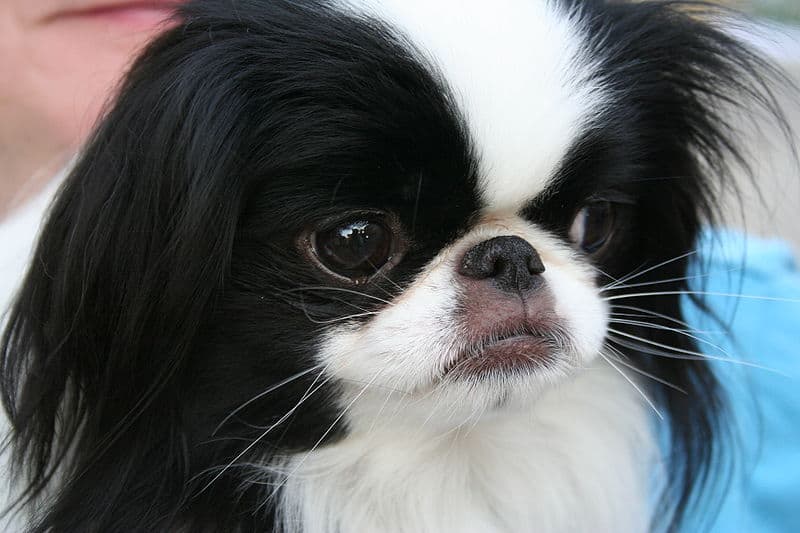
A Japanese Chin is easy to groom and train and needs only short walks.
Maintenance and Grooming
How much do Japanese Chins shed? These dogs shed an average amount of hair. But, with a simple grooming routine, an owner doesn’t have to deal with a lot of loose hair around the house.
A Japanese Chin has a single layer of hair that is both long and silky. Brushing this dog once or twice per week can help to prevent tangles and remove loose, dead hair. A pin brush is an ideal grooming tool for brushing your Japanese Chin. Be sure the pins of the brush have plastic or rubber coverings on the ends. This protects a dog’s sensitive skin.
These dog’s sometimes have bald spots or itchy areas of skin due to allergies. These skin conditions may appear in the springtime if the dog is allergic to pollen or similar particles floating in the air.
Training
Japanese Chins are relatively easy to train. Keep in mind that these are dogs with a sensitive nature. So, using a harsh voice during training is not going to be effective. Plus, it’s not a kind thing to do.
This lapdog responds best to a calm voice, treats, and words of praise. Though these dogs can have an independent streak, they are very intelligent and can pick up obedience lessons fairly quickly. The Pekingese is another dog with a sensitive nature that needs to be trained with words of praise.
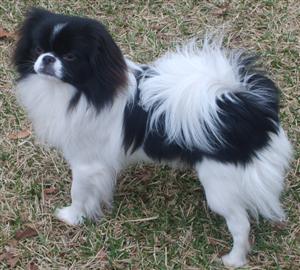
This toy dog is playful and curious as well as intelligent and loyal.
Exercise
Though this companion dog is small, it does require regular exercise. Taking it on a walk for 20 minutes per day is a good exercise routine. Owners should keep the pace slow because of this dog’s short stride.
These dogs are playful and sometimes enjoy a game of fetch with a ball they can grab and release easily. A small, fenced-in yard is appropriate for this dog as long as there are no holes or other places where it could injure itself.
Taking this dog to a dog park is not a good idea because it could be injured by larger dogs exercising there.
This dog is an ideal choice for someone who lives in an apartment as long as the person is able to give it a short walk each day. Learn more about the best dog breeds for city living here.
Puppies
When it comes to a Japanese Chin puppy, one thing to keep in mind is its diet. Overfeeding a toy puppy can cause obesity. So, an owner has to find a diet that gives the dog energy to play and explore while not overfeeding.

©Vivienstock/Shutterstock.com
Children
These dogs do best in a family with older children. Unfortunately, smaller children can make this companion dog nervous and wary. Remember this dog is always concerned about being injured due to its tiny size. Small children running around or trying to grab the dog are likely to cause the dog to growl or even bite.
Similar Dogs
Other breeds similar to these dogs include the Pekingese, the Shih Tzu, and the Pug.
- Pekingese are loyal, affectionate dogs. They need a small amount of daily exercise but require a more complicated grooming routine than Japanese Chins.
- Shih Tzu – A loyal lapdog with an affectionate, docile personality. Its colors are similar to a Japanese Chin’s coat colors. A Shih Tzu needs more grooming attention than a Japanese Chin’s.
- Pug – A toy dog that is adaptable to either home or apartment living. They are friendly, curious dogs, but shed more than a Japanese Chin.
Famous
These dogs have been companion dogs to royalty for centuries.
- Queen Victoria enjoyed the company of Japanese Chins
- Welsh Princess Aleksandra owned a few of these Toy dogs
Popular Names
Some popular names for this breed include:
- Ayaka
- Anna
- Haru
- Prince
- Rino
- Saki
- Takumi
Japanese Chin FAQs (Frequently Asked Questions)
How much does a Japanese Chin cost to own?
A Japanese Chin puppy can cost between $1500 to $2500. The cost for annual veterinary care for this breed can range from $200 to $500 depending on the purpose of the visit. Food for this toy dog can cost $50 to $100 per month depending on the brand.
What is a Japanese Chin?
A Japanese Chin is a lap dog originally bred in China. This Toy dog was created to be a companion to members of royal families. It’s an affectionate, intelligent dog with a loyal nature. It’s been described as cat-like due to its grooming habits.
What does Chin mean in Japanese?
Chin means pavilion in Japanese.
Are Japanese Chins good with kids?
This dog descended from the Tibetan spaniel, is good with older kids. Smaller kids are likely to make a Japanese Chin nervous about being injured by accident.
Are Japanese Chins good pets?
Yes, these dogs make good pets in almost any living space.
Do Japanese Chin bark a lot?
This lapdog doesn’t bark much at all, but they will alert a family of someone at the door.
Are Japanese Chins aggressive?
No. These toy dogs are known for their docile, affectionate nature.
How long does Japanese Chin live?
The lifespan of a Japanese Chin is 10 to 12 years.
Are Japanese Chins herbivores, carnivores, or omnivores?
Japanese Chins are Omnivores, meaning they eat both plants and other animals.
What Kingdom do Japanese Chins belong to?
Japanese Chins belong to the Kingdom Animalia.
What class do Japanese Chins belong to?
Japanese Chins belong to the class Mammalia.
What phylum to Japanese Chins belong to?
Japanese Chins belong to the phylum Chordata.
What family do Japanese Chins belong to?
Japanese Chins belong to the family Canidae.
What order do Japanese Chins belong to?
Japanese Chins belong to the order Carnivora.
What type of covering do Japanese Chins have?
Japanese Chins are covered in Hair.
What genus do Japanese Chins belong to?
Japanese Chins belong to the genus Canis.
What is an interesting fact about Japanese Chins?
Japanese Chins are alert, intelligent, and independent!
What is the scientific name for the Japanese Chin?
The scientific name for the Japanese Chin is Canis lupus.
What are the differences between Japanese Chins and Pekingese?
The differences between Japanese Chins and Pekingese include size, color, coat, temperament, life expectancy, and price.
Thank you for reading! Have some feedback for us? Contact the AZ Animals editorial team.
Sources
- David Burnie, Dorling Kindersley (2011) Animal, The Definitive Visual Guide To The World's Wildlife
- Tom Jackson, Lorenz Books (2007) The World Encyclopedia Of Animals
- David Burnie, Kingfisher (2011) The Kingfisher Animal Encyclopedia
- David Burnie, Dorling Kindersley (2008) Illustrated Encyclopedia Of Animals
- Dorling Kindersley (2006) Dorling Kindersley Encyclopedia Of Animals
- American Kennel Club, Available here: https://www.akc.org/dog-breeds/japanese-chin/
- Vetstreet, Available here: http://www.vetstreet.com/dogs/japanese-chin
- Wag!, Available here: https://wagwalking.com/breed/japanese-chin


















